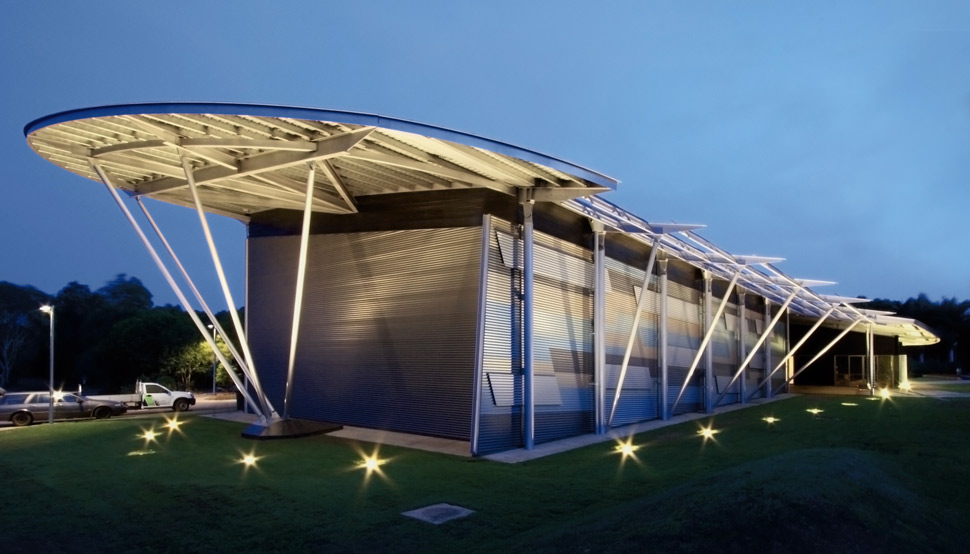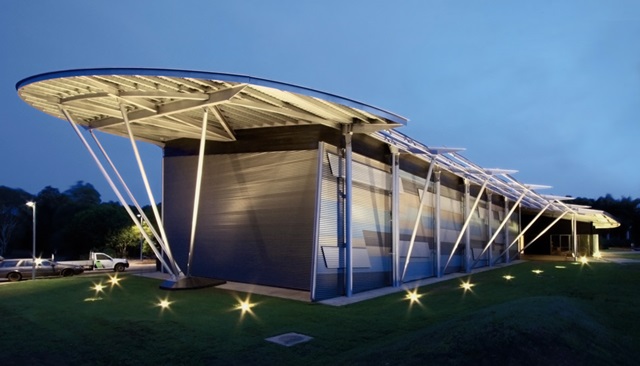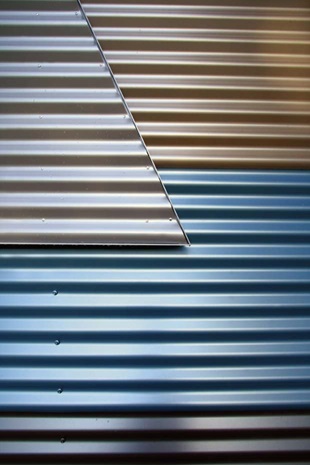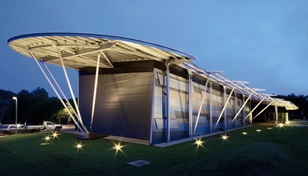Hinkler Hall of Aviation
Taking cues from the local landscape of pioneer aviator Bert Hinkler’s birthplace, the overlapping cladding of the Hinkler Hall of Aviation subtly references the bi-plane he flew from London to Darwin in 1928.
Credentials:
Client: Bundaberg Regional CouncilArchitect and Landscape Architect: Fulton Trotter Architects
Project Team: Paul Sekava, Paul Trotter, Nathan Hildebrandt, Wendy Hay, Frank Moss, Louisa McCoy, Cherissa McCaughey
Builder and Cladding Contractor: Jeff Lennox Builder
Structural & Civil Engineer: GHD
Steel Fabricator Caneland Engineering
Landscape Architects: Fulton Trotter Architects / Bundaberg Regional Council
Interpretive Design & Content: Interpretive Solutions
Building Size: 1100m2 GFA
Cost: $4.8 million
Words: Rachael Bernstone
Photography: Nathan Hildebrandt
When you fly over Bundaberg you see the patchwork appearance of farmland. It was from this image that Paul Sekava, associate at Fulton Trotter Architects in Brisbane, drew his inspiration for the innovative cladding system that adorns the Hinkler Hall of Aviation.
"We used an abstracted version of the aerial perspective to suit the building's appearance. The shape of the COLORBOND® steel sheets on the entry wall, with its diagonal edges, evokes the feeling of speed," Sekava says.
The wall features variously placed Stramit Corrugated panels made from COLORBOND® Metallic steel in the colours Citi®, Conservatory®, Cortex®, Facade® and Skybridge®.
The effect of overlapping steel sheets wasn't easy to translate from paper to built form, and involved several challenges, Sekava says.
"Fundamental issues were how to get reasonably watertight cladding, achieve variation in the colours, and not solely conform to the structural grid.
"We worked out with the builder that if we put down the first base sheet, that would provide waterproof cladding by running full-length sheets from grid to grid, varying the colour vertically, with the second colour overlaying directly onto the first sheet," the architect explains.
"We then added a third layer – in what we called the 'cloud' sheets – to achieve the three-dimensional effect.
"It went together quite quickly, although we had to innovate to get very neat diagonal edges on the sheets. Also, in some cases the sheet edges don't coincide with the stud behind, so where necessary, we riveted the second sheet against the first sheet.
"Although in the standard COLORBOND® steel range there is more variety of colour, and while some of those shades are closer to the actual landscape colours, we decided to use the COLORBOND® Metallic steel range because you get slight variations in different light and the colour change is more subtle.
"We didn't want to end up with a checkerboard effect. If we'd used the standard range, the wall would have looked more literal, but we wanted an abstraction of the landscape idea."
The eye-catching final result is a testament to the considerable efforts of many individuals who, like Bert Hinkler, endeavoured to pioneer new techniques and push known boundaries.








